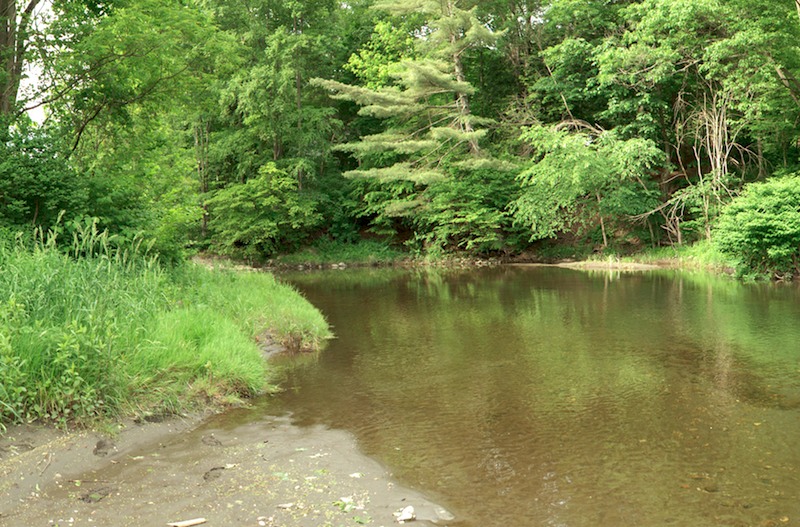One Citizen’s View of the South River, and Speed Bumps
By Bob Anderson
On the last day of February I discussed the South River with Robert Moriarty, who resides in Conway with his wife and three young children. A man with an active mind and many interests, he is a member of the Conway School Committee, while his professional life is centered in the city of Northampton, where he works as a police officer.
As a break from the tension of his work, he would vacation in his camper with his elderly father up north, in rivers and woods near the Canadian border. On a trip about ten years ago he realized the relaxation/psychic healing value of spending time in and around rivers, when he saw a moose casually feeding in a back eddy, as natural a part of the river environment as a man absorbed by fishing.
Today he is thinking of teaching traumatized uniformed professionals to fly fish. He believes it may be possible to convert their danger observation and assessment skills to the pleasant task of stalking, catching, and finally releasing fish. He hopes this intense focus might free their minds from fixation on danger, human deprivation, and despair.
As a child growing up in Amherst he played in and around the Fort River, learning how a river flows and pools, and where the turtles and minnows reside. By comparison, he became aware of the degraded condition of the South River in 2003 – seeing loss of cover for fish, heavy erosion, and river channel movement brought on by extremely high water. He was accompanied by Jim Dowd, who grew up fishing the South River. They walked the river from Reed’s bridge to the center of Conway, searching for sources of sewage. The Commonwealth’s Division of Fish and Wildlife, in tandem with the Deerfield River Watershed Association, had found E Coli bacteria in water quality assessment samples. As volunteers, the small stream of sewage they eventually found was not as disturbing as seeing the great damage from high water flows.

In particular, Robert’s heart sank when he could not find one of his favorite fishing spots. Below Natural Roots farm an undercut bank had been a haven for some small but eager trout that he had caught and released – the heavy water had washed all the cover away. Moving upstream Jim Dowd pointed out lost holding water and channel modification, as well as a general trend towards the river running more, straight, shallow, and hard. A few hundred yards from the center of town was a long wide, shallow, and very straight run that resembled a storm drain bordered by plants and trees.
On the west side of this river section is a corn field owned by the town of Conway. Years ago the river in this section was made straight, even as it now tries to meander. After the historic high water from Hurricane Irene two landowners commissioned the installation of rocks to armor the failing river banks below their houses. One of these repaired banks is just below the bridge in the center of town, where the river pushes hard towards the west bank when it runs high. Some years ago Robert noticed logs laid up to hold the bank had become exposed after a high water event. After the deluge from Hurricane Irene the logs were gone – washed somewhere downstream.
Robert understands the intent of the proposed Flood mitigation/Soil Deposition project. He says one might think of the river at flood stage as a firehouse. It carries hard running water starting from Ashfield Lake, snaking down along Route 116 into the center of Conway. The straight run below Conway center, along the field, is the nozzle pushing the water harder; eventually it will create straighter channels downstream, that would further increase the flow power. Putting in water diversion structures along the run that borders the town field would help to slow the flow, while moving the force away from threatened riverbanks, and releasing some of the power into a section of reclaimed flood plain.
If nothing is done the river will turn more and more into a very efficient, sterile, and destructive storm drain. At risk from erosion is personal property, farmland, and roads. He feels that money spent now will prevent increased expense, personal pain and loss in the future. He feels that it is now our responsibility to try and make the river better for future generations.
In Northampton his police department has been an advocate for putting speed bumps in critical traffic flow areas. Speed bumps are put in to slow the flow – Robert says speed bumps work.